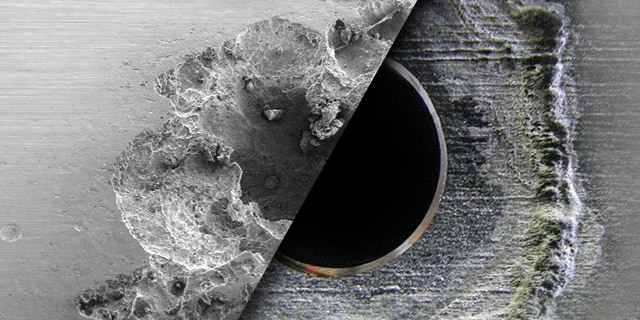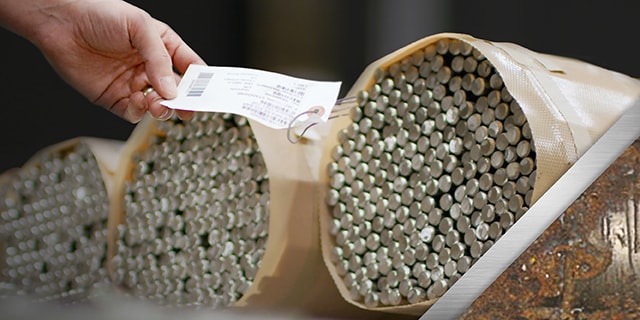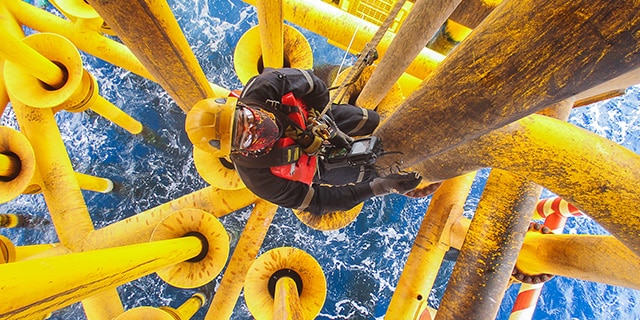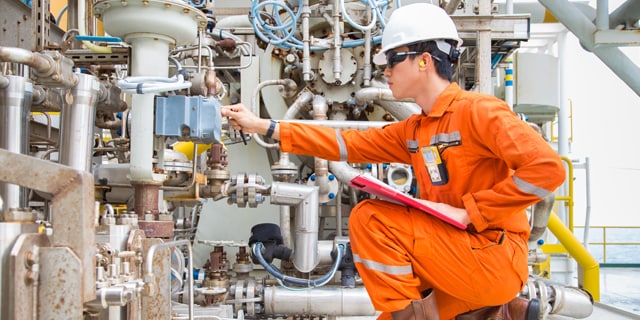Pitting Corrosion vs. Crevice Corrosion

How to Recognize and Prevent Pitting Corrosion and Crevice Corrosion
Buddy Damm, Senior Scientist, Swagelok
Corrosion—the deterioration of engineered materials by chemical interaction with their environment—is an extraordinarily costly problem. The global cost of corrosion is estimated at approximately $2.5 trillion per year.1 In offshore and nearshore oil and gas applications specifically, unchecked stainless-steel corrosion in tubing systems is a leading cause of profit loss, costing $1.373 billion each year, according to research from the National Association of Corrosion Engineers (NACE). According to NACE, these figures are attributable to “$589 million on surface pipeline and facility costs; $463 million annually in downhole tubing expenses; and another $320 million in capital expenditures related to corrosion.”2
The good news is that common types of corrosion can be mitigated or prevented with some relatively simple measures before they cause significant and costly damage to oil and gas fluid systems.
Taking proactive measures depends on your ability to identify and differentiate between a range of corrosion types and implementing appropriate solutions. Pitting corrosion and crevice corrosion are among the most common types found throughout the oil and gas industry—and some of the costliest. With this in mind, let’s break down why corrosion occurs, what differentiates pitting corrosion from crevice corrosion, and what you can do to protect your assets from corrosion-related failures.
 What is Corrosion, and What Causes Stainless Steel Corrosion?
What is Corrosion, and What Causes Stainless Steel Corrosion?
At its most fundamental level, corrosion is a set of electrochemical reactions with oxidation (loss of electrons) at an anode and a reduction (gaining of electrons) at a cathode. Nearly every metal used throughout our world corrodes under certain circumstances. For example, iron in tubing may oxidize, yielding two electrons and dissolving into water as a Fe++ positive ion. Simultaneously, the electrons from oxidizing iron may participate in a reduction reaction which uses O2 dissolved in H2O to form OH- negative ions. This creates rust, a commonly occurring byproduct of carbon steel corrosion. However, many other types of corrosion exist. Each type poses a unique threat that must be evaluated when selecting the optimal material for your application.
Metal tubing systems are most often used for analytical and process instrumentation, hydraulic lines, and control and utility applications. Many engineered metals used in oil and gas applications are made from stainless steel, which contains more than 10% chromium. The latter helps form an oxide layer that protects the metals from corrosion. Stainless steel corrosion occurs, however, when environmental conditions or mechanical damage causes that layer to break down. If the protective oxide cannot reform in a given solution, corrosion reactions may progress rapidly.
There are steps that can be taken to prevent stainless steel corrosion in oil and gas applications, particularly offshore. These steps require a fundamental understanding of the different types of corrosion and their causes. Knowing where to look for corrosion can minimize risks on oil rigs and in refineries—saving significant time and money .
 What is Pitting Corrosion, What is Crevice Corrosion, and How Do You Identify It?
What is Pitting Corrosion, What is Crevice Corrosion, and How Do You Identify It?
Numerous types of corrosion can wreak havoc on oil and gas installations, Depending on the composition of the materials of construction, the operating environment, and process fluids. But there are two forms of localized stainless steel corrosion that occur more frequently than others: pitting corrosion and crevice corrosion.
Alloy Chemistry and Resistance to Localized Attack
Both pitting and crevice corrosion occur when the environment causes a breakdown of the corrosion-resistant Cr-rich passive oxide film on stainless alloys. In offshore and nearshore environments, the chloride (Cl-) ions in seawater and the air result in damage to the passive oxide film. Alloy additions that support a more robust passive oxide film include Cr, Mo, W, and N. A pitting resistance equivalent number (PREN) is often used to represent the relative robustness of an alloy's passive oxide film to Cl- ion attack.
PREN = %Cr + 3.3x(%Mo + %W) + 16x%N
What is Pitting Corrosion?

Although the entry point of a pit may be detectable through thorough visual inspection, there may be a deep network of lost material lurking below the surface. If left unchecked, such pits can grow deep enough to perforate a tube wall entirely, causing costly leaks, environmental and safety hazards, and require expensive unplanned maintenance events. Pitting corrosion can also facilitate the initiation and growth of cracks in components under tensile loads. Environments with higher Cl- concentrations, including those created by evaporation from deposited saltwater droplets, are likely to cause pitting corrosion. Warm and humid tropical climates increase corrosion rates compared to cooler and drier climates.
When examining stainless steel tubing for pitting corrosion, look for reddish-brown iron oxide deposits as well as potential pits that may have formed on the metal surface. Pay special attention to upward-facing surfaces where Cl- bearing water (e.g., seawater) may pool and evaporate, or downward-facing areas where hanging droplets evaporate. As water evaporates, the Cl- concentration in the remaining water will increase and become more corrosive.
What is Crevice Corrosion?

In a typical fluid system, crevices exist between tubing and tube supports or clamps, between adjacent tubing runs, and underneath dirt and deposits that may have accumulated on surfaces. Crevices are virtually impossible to avoid in tubing installations, and tight crevices pose one of the greatest dangers to stainless steel integrity. In coastal or offshore applications, crevice corrosion often occurs when seawater diffuses into a crevice, leading to a chemically aggressive environment where corrosion-causing ions cannot readily diffuse out of the crevice. As a result, the local environment in the crevices becomes more aggressive as the electro-chemical reaction progresses. In such a scenario, the entire surface within the crevice can corrode at a rapid rate.
Crevice corrosion is often only observed visually when a tubing clamp is removed from the installed tubing. It is important to remember that crevice corrosion can occur at lower temperatures than pitting corrosion due to the evolution of a more corrosive environment as crevice corrosion proceeds (e.g., the tube clamp).
How Do You Stop Pitting Corrosion, and How Do You Stop Crevice Corrosion?
Corrosion can, in many circumstances, be minimized by educating workforces with basic materials knowledge and adopting corrosion-prevention best practices.
First, consider the choice of materials for tubing applications, from the tubing itself to tube supports and clamps. A higher PREN value provides greater resistance to pitting and crevice corrosion. Laboratory testing for critical pitting temperature (CPT) and critical crevice temperature (CCT)—according to the ASTM G48 standard—is an invaluable tool for comparing materials to be used in corrosive environments. CPT testing evaluates at what temperature pitting begins on a material in a specific corrosive solution. Similarly, CCT testing evaluates at what temperature crevice corrosion begins when a predefined crevice is placed on a metal sample in a corrosive solution. As PREN value increases, CPT and CCT values increase.
CPT and CCT Measured by ASTM G48 in 10% Ferric Chloride
Pitting Resistant Equivalent Number (PREN), Critical Pitting (CPT), and Critical Crevice (CCT) Temperatures
Materials that have high values for CPT and CCT are generally more suitable for use in similar corrosive environments than materials with low values. For example, 304L has the lowest CPT value of the materials shown in the figure above, while 6Mo and 2507 are among the highest for CPT and CCT temperatures for stainless steels. This indicates that 6Mo and 2507 are more resistant to pitting and crevice corrosion than 304L and 316L in chloride-bearing solutions. It is important to keep in mind that these tests are useful for comparison and material selection but are not predictive of when a material will fail in a real-life application. Nickel-based alloys like 625, C22, and C276 offer the greatest resistance to pitting and crevice corrosion.
The 316L grade of stainless steel (UNS S31603) tubing works well in many installations as long as it is kept clean and temperatures are not excessively high. In warmer climates, especially in locations where salt deposits readily form and in installations where rust from carbon steel structural beams and floors accumulates on stainless steel surfaces, corrosion of 316L stainless tubing is more readily observed. However, due to the beneficial addition of molybdenum, 316L typically preforms better than 304L (UNS S30403) stainless steel in these corrosive environments.
For situations where 316L is insufficient to meet the lifetime requirements of the application, tubing made from super austenitic (e.g., 6Mo or 6HN, UNS N08367) or super duplex (e.g., 2507, UNS S32750) stainless steels offers significantly improved corrosion resistance. Additionally, the higher yield and tensile strength of super austenitic and super duplex stainless steels make it easier to build systems that must be rated to a higher maximum allowed working pressure (MAWP). Working with your tubing and tube fittings supplier for guidance in selecting the right products and materials can help you avoid costly errors.
In addition to materials selection, careful system practices are necessary for preventing corrosion and minimizing the number of locations where crevice corrosion can occur. One way to mitigate crevice corrosion in a tube system is to avoid placing tubing directly against walls or against each other. When crevice corrosion of 316L stainless steel tubing is observed, one can replace 316L tubing with more corrosion-resistant tubing such as 6Mo, which can be installed with cost-effective 316L tube fittings in suggested mixed-material engineered combinations.

Interested in learning more? Available training programs can help arm your team with even deeper knowledge that can benefit both new team members and industry veterans. Elsewhere, explore Swagelok Reference Point for more insights on how to prevent corrosion and other ways to keep your assets operating optimally at all times.
1NACE.
2AMPP.
What is Pitting Corrosion?

Although the entry point of a pit may be detectable through thorough visual inspection, there may be a deep network of lost material lurking below the surface. If left unchecked, such pits can grow deep enough to perforate a tube wall entirely, causing costly leaks, environmental and safety hazards, and require expensive unplanned maintenance events. Pitting corrosion can also facilitate the initiation and growth of cracks in components under tensile loads. Environments with higher Cl- concentrations, including those created by evaporation from deposited saltwater droplets, are likely to cause pitting corrosion. Warm and humid tropical climates increase corrosion rates compared to cooler and drier climates.
When examining stainless steel tubing for pitting corrosion, look for reddish-brown iron oxide deposits as well as potential pits that may have formed on the metal surface. Pay special attention to upward-facing surfaces where Cl- bearing water (e.g., seawater) may pool and evaporate, or downward-facing areas where hanging droplets evaporate. As water evaporates, the Cl- concentration in the remaining water will increase and become more corrosive.
What is Crevice Corrosion?

In a typical fluid system, crevices exist between tubing and tube supports or clamps, between adjacent tubing runs, and underneath dirt and deposits that may have accumulated on surfaces. Crevices are virtually impossible to avoid in tubing installations, and tight crevices pose one of the greatest dangers to stainless steel integrity. In coastal or offshore applications, crevice corrosion often occurs when seawater diffuses into a crevice, leading to a chemically aggressive environment where corrosion-causing ions cannot readily diffuse out of the crevice. As a result, the local environment in the crevices becomes more aggressive as the electro-chemical reaction progresses. In such a scenario, the entire surface within the crevice can corrode at a rapid rate.
Crevice corrosion is often only observed visually when a tubing clamp is removed from the installed tubing. It is important to remember that crevice corrosion can occur at lower temperatures than pitting corrosion due to the evolution of a more corrosive environment as crevice corrosion proceeds (e.g., the tube clamp).
How Do You Stop Pitting Corrosion, and How Do You Stop Crevice Corrosion?
Corrosion can, in many circumstances, be minimized by educating workforces with basic materials knowledge and adopting corrosion-prevention best practices.
First, consider the choice of materials for tubing applications, from the tubing itself to tube supports and clamps. A higher PREN value provides greater resistance to pitting and crevice corrosion. Laboratory testing for critical pitting temperature (CPT) and critical crevice temperature (CCT)—according to the ASTM G48 standard—is an invaluable tool for comparing materials to be used in corrosive environments. CPT testing evaluates at what temperature pitting begins on a material in a specific corrosive solution. Similarly, CCT testing evaluates at what temperature crevice corrosion begins when a predefined crevice is placed on a metal sample in a corrosive solution. As PREN value increases, CPT and CCT values increase.
CPT and CCT Measured by ASTM G48 in 10% Ferric Chloride
Pitting Resistant Equivalent Number (PREN), Critical Pitting (CPT), and Critical Crevice (CCT) Temperatures
Materials that have high values for CPT and CCT are generally more suitable for use in similar corrosive environments than materials with low values. For example, 304L has the lowest CPT value of the materials shown in the figure above, while 6Mo and 2507 are among the highest for CPT and CCT temperatures for stainless steels. This indicates that 6Mo and 2507 are more resistant to pitting and crevice corrosion than 304L and 316L in chloride-bearing solutions. It is important to keep in mind that these tests are useful for comparison and material selection but are not predictive of when a material will fail in a real-life application. Nickel-based alloys like 625, C22, and C276 offer the greatest resistance to pitting and crevice corrosion.
The 316L grade of stainless steel (UNS S31603) tubing works well in many installations as long as it is kept clean and temperatures are not excessively high. In warmer climates, especially in locations where salt deposits readily form and in installations where rust from carbon steel structural beams and floors accumulates on stainless steel surfaces, corrosion of 316L stainless tubing is more readily observed. However, due to the beneficial addition of molybdenum, 316L typically preforms better than 304L (UNS S30403) stainless steel in these corrosive environments.
For situations where 316L is insufficient to meet the lifetime requirements of the application, tubing made from super austenitic (e.g., 6Mo or 6HN, UNS N08367) or super duplex (e.g., 2507, UNS S32750) stainless steels offers significantly improved corrosion resistance. Additionally, the higher yield and tensile strength of super austenitic and super duplex stainless steels make it easier to build systems that must be rated to a higher maximum allowed working pressure (MAWP). Working with your tubing and tube fittings supplier for guidance in selecting the right products and materials can help you avoid costly errors.
In addition to materials selection, careful system practices are necessary for preventing corrosion and minimizing the number of locations where crevice corrosion can occur. One way to mitigate crevice corrosion in a tube system is to avoid placing tubing directly against walls or against each other. When crevice corrosion of 316L stainless steel tubing is observed, one can replace 316L tubing with more corrosion-resistant tubing such as 6Mo, which can be installed with cost-effective 316L tube fittings in suggested mixed-material engineered combinations.

Interested in learning more? Available training programs can help arm your team with even deeper knowledge that can benefit both new team members and industry veterans. Elsewhere, explore Swagelok Reference Point for more insights on how to prevent corrosion and other ways to keep your assets operating optimally at all times.
1NACE.
2AMPP.
Related Articles

Material Matters: Selecting the Right Material for Corrosion Resistance
An offshore platform can have nearly 50,000 feet of tubing, more than 20,000 fluid system components, no fewer than 10,000 fittings, and as many as 8,000 mechanical connections. No wonder choosing corrosion-resistant material isn’t easy. Learn how to make choices right for your application.

Enhance Safety and Save with Optimized Materials
Discover how offshore platform owners can optimize their material selection for tube and tube fittings to control costs and enhance safety in a variety of applications.

4 Answers on Material Selection for Sour Oil and Gas Fields
As oil and gas production expands into sour environments high in hydrogen sulfide, material reliability becomes critical. Learn how proper material selection and adherence to NACE standards can keep your system running efficiently.



